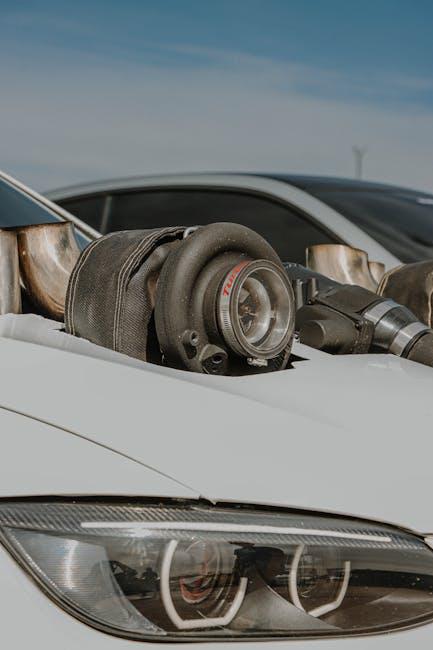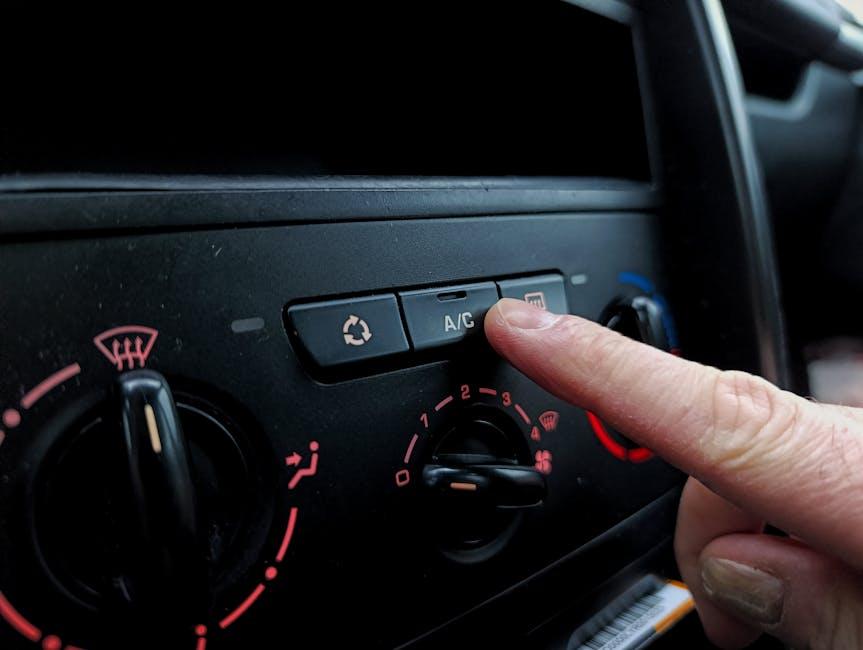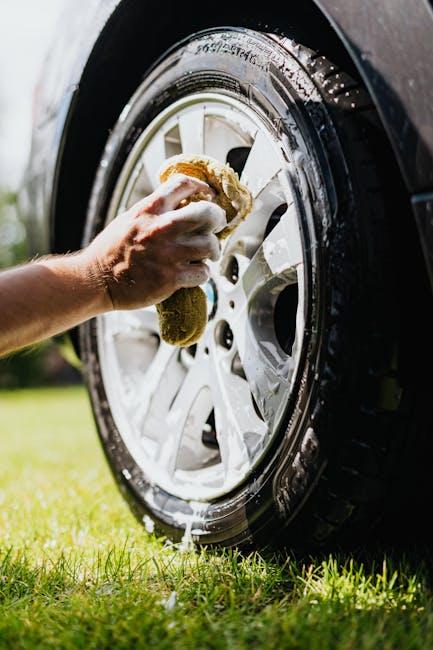When summer’s heat blazes on the asphalt, your car’s air conditioning becomes more than a luxury—it’s a lifeline. Yet, even the most reliable vehicle can fall victim to common AC woes, turning a refreshing drive into a sweaty struggle. Understanding these familiar problems and knowing how to address them can keep your cool intact, no matter how high the mercury rises. In this article, we’ll explore the typical car AC malfunctions and offer practical solutions to help you breathe easy on every journey.
Table of Contents
- Common Causes of Car AC Failure and How to Identify Them
- Understanding Refrigerant Issues and Effective Recharging Tips
- Diagnosing Compressor Problems and When to Seek Professional Help
- The Role of Condenser and Evaporator in AC Performance
- Preventing Electrical Faults in Your Car’s Air Conditioning System
- Routine Maintenance Practices to Keep Your Car AC Running Smoothly
- Q&A
- Concluding Remarks

Common Causes of Car AC Failure and How to Identify Them
When your car’s AC system starts to falter, pinpointing the issue quickly can save you time and money. One of the most frequent culprits is a refrigerant leak, often caused by worn-out seals or punctured hoses. Another common problem is a faulty compressor, which acts like the heart of the cooling system; if it fails, the entire AC unit may stop chilling effectively. Pay attention to any unusual noises or a drop in cooling performance, as these signs often indicate internal mechanical issues. Additionally, clogged or dirty air filters can reduce airflow and strain the system, leading to suboptimal cooling inside your vehicle.
To diagnose these symptoms early, watch out for:
- Weak airflow from the vents despite the fan running at high speed.
- Unusual odors when the AC is turned on, often signaling mold growth or debris buildup.
- Intermittent cooling that might point to electrical faults or sensor failures.
- Visible leaks or pooling fluid under the car, signaling refrigerant loss.
| Symptom | Possible Cause | How to Identify |
|---|---|---|
| Warm air from vents | Low refrigerant | Check for hissing sounds or oily residue |
| AC cycles on/off frequently | Electrical issues | Observe rapid compressor cycling |
| Musty smell | Mold in ducts | Smell damp or stale air |
With regular inspection and by recognizing these patterns early, you can keep your car’s AC system running smoothly throughout every season.

Understanding Refrigerant Issues and Effective Recharging Tips
One of the primary reasons your car AC might underperform or completely fail is due to refrigerant issues. Refrigerant is the lifeblood of the AC system, responsible for absorbing and dissipating heat. When there’s a leak or improper refrigerant level, the cooling efficiency drops dramatically. Common signs include warm air blowing from vents, hissing noises, or an oily residue around AC components, signaling a refrigerant leak. Addressing these issues early can prevent damage to vital parts like the compressor, which can be costly to repair.
When it comes to recharging the refrigerant, it’s essential to follow a proper process to avoid overcharging or undercharging, both of which can harm your system. Here are some effective tips to keep in mind:
- Check for leaks before adding refrigerant to ensure the system isn’t losing pressure.
- Use the correct refrigerant type specified by your vehicle’s manufacturer.
- Use proper gauges and tools to monitor pressure levels during recharging.
- Avoid overcharging as it can increase system pressure and risk component damage.
| Common Symptom | Possible Cause | Recommended Action |
|---|---|---|
| Warm air from vents | Low refrigerant level | Inspect for leaks and recharge refrigerant |
| Hissing noise | Refrigerant leak | Locate and repair leak before recharging |
| AC compressor not engaging | Improper refrigerant pressure | Check and adjust refrigerant levels |

Diagnosing Compressor Problems and When to Seek Professional Help
Recognizing compressor issues early can save you from costly repairs and ensure your car’s AC system functions smoothly. Common signs include unusual noises like grinding or squealing when the AC is switched on, inconsistent cooling, or a complete lack of cold air despite the system running. Visual clues such as oil stains around the compressor area or damaged belts can also indicate trouble. If your car’s cabin doesn’t cool down as it used to or the compressor clutch fails to engage, these are clear red flags that warrant closer inspection.
While minor compressor hiccups may occasionally be resolved with simple maintenance like belt adjustments or refrigerant top-ups, some problems demand a professional touch. Compression pressure imbalances, internal bearing failures, or a seized compressor require specialized tools and expertise to diagnose and fix correctly. Attempting to repair these complex issues without experience often leads to further damage. If you encounter the symptoms below, it’s best to consult an experienced technician:
- Persistent loud noises coming from the compressor unit
- Irregular clutch engagement or total failure to engage
- Frequent system shutdowns while the AC is running
- Visible leaks or oil residue near the compressor
| Symptom | Potential Cause | Recommended Action |
|---|---|---|
| Squealing noise | Worn belts or clutch issues | Professional belt inspection & replacement |
| Weak cooling | Low refrigerant or compressor inefficiency | Recharge system & compressor check |
| AC shuts off suddenly | Electrical faults or overheating | Diagnostic testing required |

The Role of Condenser and Evaporator in AC Performance
The condenser and evaporator are the unsung heroes behind your car’s cooling system, working in tandem to keep cabin temperatures comfortable. The condenser, positioned in front of the radiator, acts like a radiator itself, transforming high-pressure refrigerant gas into a cool liquid by dissipating heat to the surrounding air. This process is critical because it sets the stage for the evaporator to absorb heat from inside the vehicle, creating that refreshing cold air you rely on during hot drives. Without a properly functioning condenser, the system can overheat and the AC’s performance will plummet.
Meanwhile, the evaporator is nestled inside the dashboard, where it serves as the cold heart of the system. As the low-pressure liquid refrigerant flows through the evaporator coils, it absorbs heat from the air blowing across it, causing the refrigerant to evaporate back into gas form. This cycle cools the air before it reaches your vents, efficiently reducing the cabin temperature. Common malfunctions such as refrigerant leaks or clogged coils in either component can lead to insufficient cooling or foul odors. Regular maintenance of these parts not only enhances cooling efficiency but also prolongs the lifespan of your vehicle’s AC system.
| Component | Function | Common Issues |
|---|---|---|
| Condenser | Converts refrigerant gas to liquid by releasing heat | Blockages, leaks, corrosion |
| Evaporator | Absorbs cabin heat, vaporizing refrigerant to cool air | Clogged coils, leaks, mold buildup |
- Keep condenser fins clean to ensure optimal heat dissipation.
- Inspect evaporator for leaks to avoid refrigerant loss and odors.
- Schedule professional AC check-ups to maintain system balance and performance.

Preventing Electrical Faults in Your Car’s Air Conditioning System
Electrical faults in your car’s air conditioning system can be tricky to diagnose but are often preventable with regular care. One effective approach is to frequently inspect the wiring harnesses and connectors for signs of wear, corrosion, or loose connections. Over time, vibrations and engine heat can cause wires to fray or terminals to oxidize, impeding the electrical flow needed for the AC components to function properly. Incorporating a quick visual check whenever you perform routine maintenance helps catch small issues before they escalate into costly repairs.
Proactive tips to keep your AC’s electrical system healthy:
- Clean connectors using electrical contact cleaner to improve conductivity.
- Ensure secure mounting of wires to prevent chafing against metal parts.
- Use dielectric grease on terminals to guard against moisture intrusion.
- Test fuses and relays periodically to confirm proper operation.
- Replace aging wiring segments with high-quality, heat-resistant cables.
| Issue | Potential Cause | Recommended Action |
|---|---|---|
| Intermittent AC operation | Loose connector or corroded terminal | Secure and clean electrical contacts |
| AC not turning on | Blown fuse or faulty relay | Inspect and replace fuse/relay as needed |
| Weak cooling performance | Damaged compressor wiring | Repair or replace wiring harness |

Routine Maintenance Practices to Keep Your Car AC Running Smoothly
Regularly caring for your car’s AC system can prevent many common issues before they start. Ensure you check and replace the cabin air filter every 15,000 to 20,000 miles to maintain efficient airflow and reduce contaminants inside your vehicle. Additionally, running the AC system on a regular basis, even during cooler months, helps keep the compressor seals lubricated and prevents leaks. Don’t forget to inspect the belt and hoses connected to the AC compressor for any signs of wear or cracks, as these components are critical to smooth operation.
Periodic professional inspections are invaluable, but you can also perform simple upkeep at home:
- Clean the condenser: Remove debris, leaves, or dirt blocking airflow at the front of the radiator.
- Monitor refrigerant levels: Low refrigerant causes poor cooling and can damage compressor parts.
- Observe unusual noises: Rattling or squealing sounds may indicate compressor or belt issues.
| Maintenance Check | Recommended Frequency | Benefit |
|---|---|---|
| Cabin Air Filter Replacement | Every 15,000-20,000 miles | Improved air quality and airflow |
| Refrigerant Level Check | Annually | Optimal cooling efficiency |
| Compressor Belt Inspection | Every 6 months | Prevents sudden breakdowns |
Q&A
Q&A: Common Car AC Problems and Solutions
Q1: Why is my car’s AC blowing warm air instead of cold?
A1: When your car’s AC blows warm air, it’s often due to low refrigerant levels, which can result from leaks in the system. Another cause could be a malfunctioning compressor or a clogged condenser. The solution typically involves checking for leaks, recharging the refrigerant, or replacing faulty components.
Q2: What causes a strange odor coming from the car AC?
A2: A musty or moldy smell usually indicates moisture buildup in the evaporator, leading to mold and mildew growth. This can happen if the AC system isn’t drained properly or is rarely used. To fix this, clean the evaporator and replace the cabin air filter regularly. Using an antibacterial spray designed for car ACs can also help.
Q3: Why does the AC make loud noises when turned on?
A3: Noises such as grinding, squealing, or rattling could signal worn-out bearings in the compressor, a failing clutch, or debris stuck in the system. Early diagnosis and repair prevent further damage. A thorough inspection and timely part replacement are the best solutions.
Q4: What should I do if the AC turns off suddenly?
A4: The AC shutting off unexpectedly could be a sign of electrical issues, like a blown fuse or a faulty relay. It may also indicate the system is overheating due to insufficient coolant or refrigerant. Check the electrical components and refrigerant levels, and service as necessary.
Q5: How often should the car’s AC system be serviced?
A5: Regular maintenance, ideally once a year, helps keep your AC running efficiently. This includes checking refrigerant levels, replacing filters, cleaning condensers, and inspecting belts and hoses. Preventative care reduces the chance of sudden breakdowns and expensive repairs.
Q6: Can I fix car AC problems myself?
A6: Minor issues like replacing the cabin air filter or recharging refrigerant (with proper equipment) can sometimes be DIY tasks. However, many car AC problems—especially leaks, compressor failures, or electrical faults—require professional diagnosis and repair to ensure safety and effectiveness.
Q7: Why does my car AC’s cooling performance decrease over time?
A7: Over time, dirt and debris can clog the condenser and cabin air filters, reducing airflow and cooling efficiency. Additionally, refrigerant may gradually leak out. Regular cleaning and maintenance will restore peak performance.
Q8: Is it normal for the AC to have some water dripping underneath the car?
A8: Yes, water dripping from the AC system is usually condensation from the evaporator and is perfectly normal. If leaks are excessive or accompanied by oily residue, it might indicate refrigerant leaks that need attention.
This Q&A offers a creative yet straightforward guide to understanding and addressing common car AC problems, blending practical advice with clear explanations.
Concluding Remarks
As the summer sun blazes outside, a well-functioning car AC isn’t just a comfort—it’s a necessity. Understanding common AC problems and how to tackle them empowers you to keep your cool no matter the heat. Whether it’s a simple recharge or a more intricate repair, early attention can save both your comfort and your wallet. So, the next time your car’s chill starts to fade, remember: a little knowledge goes a long way toward turning the heat down and the drive up. Stay cool, stay informed, and enjoy every journey in refreshing comfort.

